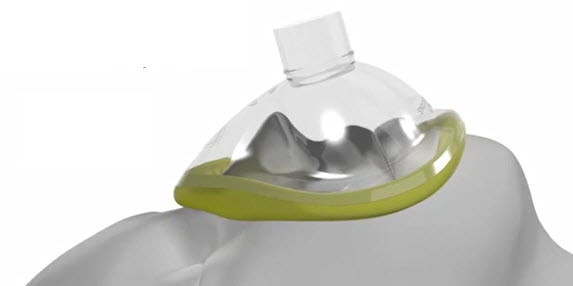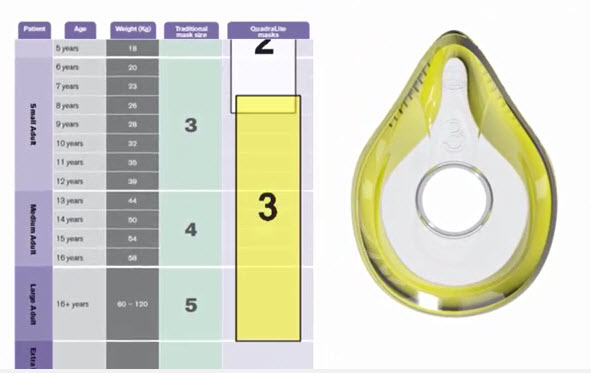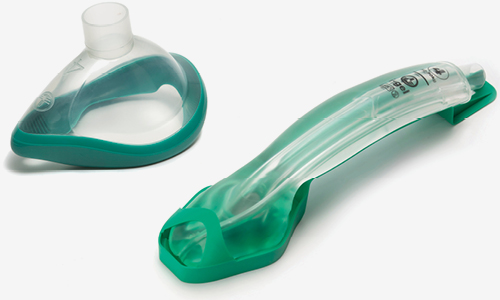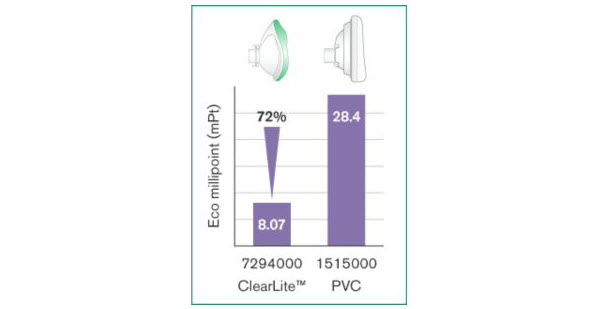Anaesthetic face masks are designed to administer anaesthetic gases to a patient during spontaneous or manual ventilation. An anaesthetic mask fits over the mouth and nose to create an air tight seal and are used to oxygenate patients pre operatively or administer a general anaesthetic (GA).
The mask is connected to a breathing system at the start of the GA to initially administer oxygen, followed by nitrous oxide, if used, and then the anaesthetic volatile such as Sevoflurane. Once the patient is asleep, the mask is removed and the breathing system is connected to an airway device such as an i-gel® supraglottic airway. The face mask is used again at the end of the anaesthetic to administer oxygen to aid recovery from anaesthesia.
Sometimes, but rarely, the anaesthetists might hold the mask in place for the entire procedure if it is short or use a harness to secure the mask in place if it is a longer procedure.
Related Pages
- Anaesthetic face masks
- Single use anaesthetic face masks
- Reprocessable anaesthetic face masks
How to select a mask?
There are many factors taken into consideration before choosing the type of mask used for any anaesthetic procedure.
Some hospital protocols will stipulate that they must use disposable or single-use masks to eliminate the chances of contamination between patients. Even these hospitals may hold a small stock of reprocessable masks for difficult airways.
The clinician may have a preference, for example the type of mask they believe will work best for the patient or the clinician's familiarity with the product. The key feature that most users look for is a mask that provides the best seal for the patient; some prefer a cushion to obtain a good leak tight fit; others prefer a lip type seal. Price and purchasing budgets may also influence how a face mask is chosen and used.

Selecting the correct size of face mask
The only part of the patient’s face that needs to be covered with an anaesthetic face mask is the nose and mouth, there is no need to choose a face mask that covers more of the face. For example, a person with a wide face does not necessarily need a wide face mask as the size of the face mask is generally based on the age and weight of the patient.
Traditionally there have been seven sizes available, starting at size zero (0) up to a size seven (7). This range provides a unique anatomical shape and requires minimal downward pressure to achieve an airtight seal which results in only four sizes required to meet all patient needs.
To assist your selection of the correct anaesthetic face mask we have an anaesthetic face mask comparison poster which details of all the products in our product range and compares the size mask within each range. This poster can be found in the releated documents section, lower down on this page.

Face mask colour coding
Often it is not easy to see the size number on anaesthetic face masks, so colour is the best option. Colour coding of either the hook ring or any part of the mask can help a user identify more easily the size of mask. The same colour coding is used across Intersurgical's range of anaesthetic face masks, and products within other ranges, such as the i-gel® supraglottic airway range.

Hook rings for masks
A hook ring was originally provided with an anaesthetic face mask because it was common practice to use a mask harness or head strap in order to secure the mask in position. It was used in this way for patients breathing spontaneously during anaesthesia, with a guedel airway to protect the airway and the mask secured in position by the head strap to deliver the anaesthetic gases.
Today with the increased use of supraglottic airways it has changed the practice to a point where hook rings are rarely used and often removed and discarded prior to use of the mask. In fact a number of anaesthetists also claim that the presence of the hook ring also makes it uncomfortable to hold the mask and can damage their protective gloves.
There has been a renewed focus regarding the plastic waste in the anaesthesia; one of which is the use of hook rings supplied with face masks.
Intersurgical is committed to lowering the environmental impact of our products and services, and with this in mind we have now made all our anaesthetic face masks available without a hook ring. In addition our ClearLite™ range of anaesthetic face masks are non-PVC and phthalate free reducing the environmental impact associated with PVC.

The environmental challenge
There is a growing concern about the environmental issues associated with the use of plastics in products that are in use within the medical environment. There is particular concern with the disposal of PVC products especially when it involves incineration, due to potential release of environmentally harmful gases.
Whilst there are not any current viable alternatives to replace the use of plastics in many medical products there are materials that can offer an alternative to the use of PVC. As part of our continual improvement programmes, we aim to reduce the environmental impact of our products and processes. This has resulted in a search for alternative materials to PVC to help address these concerns.
The challenge was to find alternate materials that mimic the characteristics of PVC without the negative side effects. An essential requirement of a material used to manufacture an anaesthetic mask is that it should be soft enough to provide a good seal on a wide range of face shapes and be comfortable for the patient. In addition it should have sufficient transparency to enable the nose and mouth to be visualised whilst enough rigidity to maintain its form throughout use. In our search for alternative materials we were looking for something that would reduce the environmental impact whilst offer the patient and clinician improved levels of comfort and performance.
The plastics pyramid illustrated below shows PVC as the most harmful material to the environment and polypropylene (PP) and Thermo plastic elastomer (TPE) to be much less harmful, which helped in our choice.
We have introduced a material into our ClearLite™ anaesthetic face masks so we can offer non-PVC and phthalate free alternative ranges. View our single use anaesthetic face masks to review these ranges in more depth.

Comparing the environmental impact of products
We have used SimaPro 8 Life Cycle Assessment (LCA) software to assess the environmental aspects of our products following the ISO standards 14040:2006 and 14044:2006. By analysing the materials, packaging, energy used in manufacturing and disposal methods, this software enables us to quantify the environmental impact of our products, providing a number in units of Eco millipoints, which allows for all impact categories to be provided in a single value, including carbon emissions.
The example illustrates the reduction of environmental impact between a traditional PVC anaesthetic face mask and the ClearLite™ anaesthetic face mask.
Products with lower Eco millipoints scores are more environmentally friendly, the ClearLite™ shows a 72% reduction in environmental impact.1
| Code | Description | Eco millipoint score |
| 7294000 | ClearLite™ anaesthetic face mask, size 4, adult, green seal 22F - non PVC | 8.07 |
| 1515000 | Economy anaesthetic face mask, size 4, medium adult 22F - PVC | 28.4 |
Reference 1: Life Cycle Assessment (LCA) Comparison of non-PVC and PVC Oxygen Masks (issue 2)



























